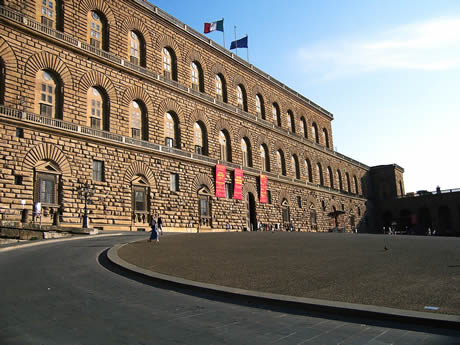Palazzo Pitti

Palazzo Pitti is, some belief, the most impressive civil building in Florence, exceeding much by dimensions and artistic patrimony the Palazzo Vecchio. Paradoxically or not, the palace still bares the name of its original owner, Luca Pitti, who had the construction started in the year 1458. The Pitti family lived in the palace no more than a century, since the Medici family purchased the establishment in 1549 in view of moving from the back then Palazzo della Signoria, subsequently named the Palazzo Vecchio.
The Medici have largely extended the initial structure (said to have consisted, prior to the arrival of the Medici, only of the cubical structure in the middle of the current building) designed by Brunelleschi and Luca Fancelli (though its authorship is still subject to debate). Nowadays, the Palazzo Pitti makes its way through by its reputation as the second most valuable art gallery and museum complex only after the Uffizi Gallery to which, for that matter, it is connected by the famed Vasari Corridor via Ponte Vecchio (the Old Bridge). The last famous inhabitants of the Pitti Palace were the house of Lorraine and Savoy, following the death of the last heir of the Medici family. Vasari was the architect commissioned first to enlarge the initial structure, though extension works were carried out until the first half of the 17th century, partly due to the fact that the palace had to be harmoniously linked to the subsequently purchased Boboli Gardens intended to be transformed into a sumptuous backyard of the Palazzo Pitti.

Nicolo Pericoli dubbed Tribolo was the initial landscape designer of the Boboli Gardens, but given his unexpected death, he was soon replaced by Bartolomeo Ammannati. The Palazzo Pitti and the Boboli Gardens form huge impressive tourist hotspot of Florence south of the Arno River, the density of the artistic masterpieces populating it requiring much patience and curiosity from the part of the visitors keen on getting to know Florence in thorough detail. Thus, the complex consisting of the palace and the gardens hosts 7 museums and galleries. The Palazzo Pitti proper hosts the Palatine Gallery, the Royal Apartments, the Silver Museum, the Carriage Museum and the Costume Gallery, whereas the Porcelain Museum is located in the Boboli Gardens, more precisely, in the Cavalier’s Casino in the Cavalier’s Garden. To begin with, the Palatine Gallery features a striking dash of personal art collection, given there is no apparent scientific criteria of arranging the paintings it displays – such as classification by author or year if creation – except the personal subjective taste.
The Palatine Gallery fills the entire first floor of the left wing of the Palazzo Pitti, clustering masterpieces pertaining to famous Renaissance and Baroque artists, such as Rubens, Titian, Raphael and Correggio, as well as to Pietro da Cortona. The Royal Apartments are in obvious contradistinction to the dimensional grandness of the Palatine Gallery, though they maintain the same taste for ornamentation and artistic sensitivity in conceiving the facilities of everyday life. The Modern Art Gallery is located on the second floor of the palace, in the rooms formerly inhabited by the Grand Dukes of the Medici family. Almost two centuries of sculptural and pictorial art are represented by various exhibits dating back as early as the end of the 18th century to early 20th century. Located on the ground floor of the left wing of the Pitti Palace, the Silver Museum does not focus exclusively, despite the reference implied in its name, on exhibiting silver items. On the contrary, the display also consists of decorative items and jewels made of gems, crystal and semi-precious stones, but it also comprises carpets and clocks, for instance.
The Costume Gallery is deemed by some the only museum in Florence which covers the topic of fashion from a historic point of view, with clothing and accessories from the 16th to the 20th century, amounting to some six thousand exhibits. The Costume Gallery overlooks the Boboli Gardens, being conveniently located in the Palazzina della Meridiana. As to the Carriage Museum, it is hosted in the ground floor of the Pitti Palace, and its highlights refer to the gilt and floridly embellished and decorated carriages used by the Grand Dukes in the 18th and the 19th century. Finally, the Porcelain Museum is hosted by the Cavalier’s Casino located in the Cavalier’s Garden, part of the Boboli Gardens, and it displays a collection of dinning tools and other related items, all made of porcelain, used in the past by the Grand Ducal families.
- Name:
- Palazzo Pitti
- Address:
- 1 Piazza Pitti, Florence
- Telephone number:
- 0039 (0)55 23885
- Fax:
- 0039 (0)55 238 8699
- Website:
- www.polomuseale.firenze.it